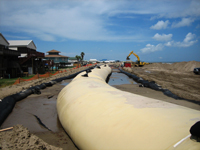
30 finalists selected for JEC Innovation Awards
TenCate Geosynthetics has announced that it is involved in projects in both Nigeria and the United States, in which TenCate Geotube technology is being deployed. In Nigeria, Geotube is being used to strengthen and protect river banks in the Niger delta and in the USA, Â TenCate Geosynthetics is working with the U.S. Corps of Engineers on the rehabilitation and protection of the coastal strip of Grand Isle in New Orleans (Louisiana). TenCate Geotube technology is a system de
2nd June 2009
Innovation in Textiles
|
Almelo
 TenCate Geosynthetics has announced that it is involved in projects in both Nigeria and the United States, in which TenCate Geotube technology is being deployed. In Nigeria, Geotube is being used to strengthen and protect river banks in the Niger delta and in the USA, TenCate Geosynthetics is working with the U.S. Corps of Engineers on the rehabilitation and protection of the coastal strip of Grand Isle in New Orleans (Louisiana).
TenCate Geosynthetics has announced that it is involved in projects in both Nigeria and the United States, in which TenCate Geotube technology is being deployed. In Nigeria, Geotube is being used to strengthen and protect river banks in the Niger delta and in the USA, TenCate Geosynthetics is working with the U.S. Corps of Engineers on the rehabilitation and protection of the coastal strip of Grand Isle in New Orleans (Louisiana).
TenCate Geotube technology is a system developed by TenCate, in which a very large tubular textile container is filled with sand or sludge that is available locally. As this system uses local building materials, the company says that it is a more sustainable solution than traditional materials for shoreline protection, such as concrete, boulders or stones, which often have to be transported over great distances. TenCate also claims the system is more effective than the reclaiming of sand, some of which will again be carried away by the force of the water. TenCate Geotube can also easily be integrated into the landscape and is thus also of ecological value, TenCate adds. The technology has now proved itself in numerous applications globally and is increasingly regarded throughout the world as a sustainable solution, the company says.
The Niger Delta Development Commission started on the development of the Niger delta several years ago. The banks of the Niger are extremely susceptible to erosion and as a result, there is a constant threat of houses subsiding and entire villages disappearing. TenCate Geosynthetics says that its technology proved the most suitable solution to this problem. In order to withstand the pressure of currents and waves, scour aprons were installed on the riverbed, to prevent it being worn away by the action of the currents and TenCate Geotube units are installed on top of these.
TenCate Geosynthetics North America is working in Louisiana (USA) with the U.S. Corps of Engineers on a project on Grand Isle near New Orleans. The project aims at rehabilitating the beaches that were damaged by hurricanes Gustav and Ike in 2008 and at the protection of the coastline here. To this end, a row of TenCate Geotube containers, measuring some 9,600 metres, laid end-to-end, will be installed. The containers form the core of what will eventually become a range of dunes, created by drifting sand. The system stimulates natural dune formation without large amounts of sand having to be sucked up, which can disrupt life on the seabed. A special coating ensures that the sand on the dune is not swept away during a hurricane and offers extra protection against degradation and collapse of the system as a result of UV radiation.
As a supplier of geotextiles from way back, TenCate is involved in major civil engineering projects throughout the world. The company says that these striking projects are of importance for directing greater attention globally to sustainable building methods that save the environment and minimize the transport of building materials.
Geotube technology is characterised by three stages:
Containment:
A high strength permeable fabric with uniquely designed retention properties is fabricated into Geotube containers that can be filled with fine grain sludge, hazardous contaminated soils, or dredged waste materials.
Dewatering:
Excess water drains from the Geotube containers through the small pores in the fabric resulting in effective dewatering and efficient volume reduction of the contained material. This volume reduction allows for the repeated filling of the Geotube container. In many cases the decanted water is of a quality that can be returned to native waterways or for reuse.
Consolidation:
After the final cycle of filling and dewatering, the retained fine grain materials can continue to consolidate by desiccation because the residual water vapour escapes through the fabric.

Business intelligence for the fibre, textiles and apparel industries: technologies, innovations, markets, investments, trade policy, sourcing, strategy...
Find out more